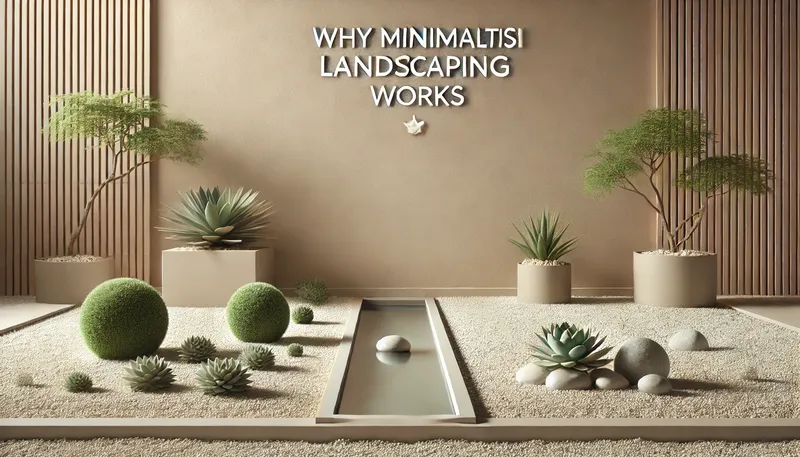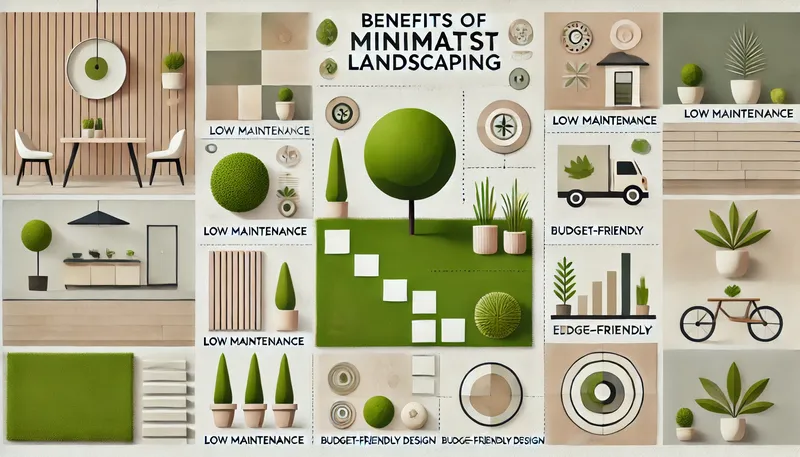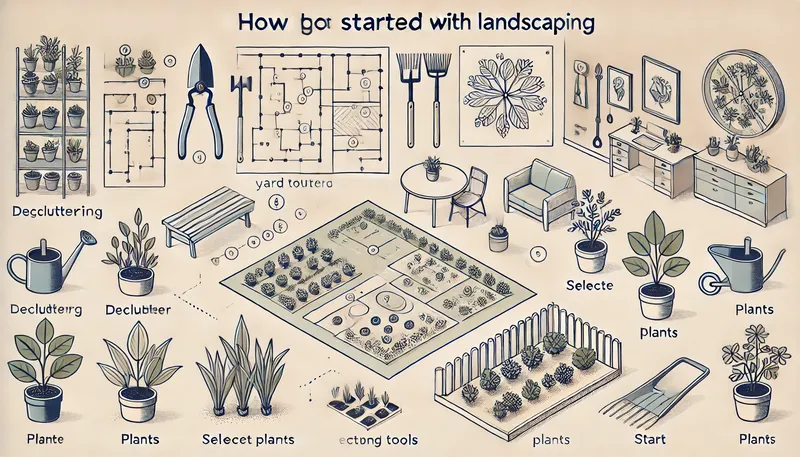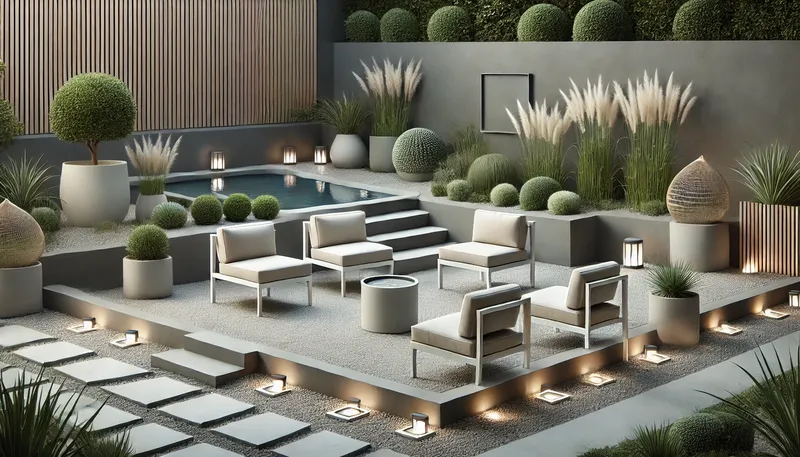Minimalist landscaping ideas – A minimalist approach to the interior of the building is not only related to having few shrubs or accessories.
It’s all about designing an outdoor area that can be effectively used for social settings and still look relaxing, sanitized, and functional.
For those concerned about clean lines but like the addition of nature, this is a way to enhance your yard.
Now it’s time to explore the principles of using minimalist landscaping elements in your space and inspire you to create a calm oasis.
Why do Minimalist Landscaping strategies work?

Minimalism is all about the idea that simplicity is best. In landscaping, this translates to:
- Clean lines
- Neutral colors
- Thoughtful plant selection
- Low-maintenance design
They do not only transform your yard to look fantastic but also are low maintenance. What if you could reduce the time you spend taking care of your lawn, pulling weeds, and being able to relax in the garden instead?
Ten Facts about Minimalist Landscaping Ideas
1. Stick to Simple Shapes
In terms of shapes, avoid ambiguous shapes when choosing designs for your landscape. Squares, rectangles, and circles are, in essence, looking and give an orderliness that is quite appealing. Here’s why they work so well:
- Visual balance: Simple shapes create harmony.
- Ease of design: These shapes are duplicable and, therefore, can be easily administered compared to other irregular shapes.
- Versatility: These are perfect for lawns, patio areas, and garden space.
Pro Tip: If you want something more eye-catching but not as busy, straight pathways and curved edges of an object will do.
2. Choose a Limited Plant Palette
Instead of making the whole yard home to different types of plants that you like, take time and just choose a few. Here’s how to do it:
- Pick low-maintenance plants: Water-saving plants such as succulents, ornamental grasses, and evergreen plants are quickly grown in this landscape type.
- Go monochromatic: Select plants of a similar hue – all green or grey-green plants- for the modern feel of the interior.
- Cluster plants strategically: Arrange them in small groups to positively impact the traffic area without congesting it.
3. Use Gravel and Stone
Famous landscaping materials such as gravel and stone are part of minimalism. It is a bonus that they also create a multidimensional design without bringing in unnecessary frills. Consider these uses:
- Pathways: Use gravel to create a path for a modern design.
- Garden beds: Remove the mulch and top it up with stones to give a pleasing appearance that lasts longer.
- Zen garden vibes: Lay flat or rolled stones in the sand for a minimalist, calming atmosphere.
Stones are rigid and blend so well with plants that they contrast nicely with wooden structures.
4. Keep a Neutral Color Scheme
The idea of minimalism in landscapes works best when the colours are not complicated. Stick with neutral tones like:
- Gray
- White
- Beige
- Black accents
You can introduce colour through flowers or planters, but the primary base colours should be moderate.
As you can imagine, the different sections of your yard leave all the details looking well-defined as they should feel and look on a canvas.
5. Add Hardscaping Elements
A hardscape is anything that is nonliving in your yard. This includes:
- Patios and decks
- Fences
- Paved walkways
For a minimalist touch:
- The best materials for smooth and polished looks are concrete and wood.
- Select plain furniture—a bench for people to sit on, a single set of chairs.
- Avoid overdoing objects, especially decorative ones, which should be few.
6. Embrace Open Space
Minimalism loves open space. The objective here isn’t to stage your lawn so there is no unused space in the entire yard. Instead:
- Leave room to breathe: Let your design make you feel like there is a lot of space.
- Highlight critical areas: Aim to concentrate on at least one or two derivative components, such as trees, fountains, or sculptures.
- Enjoy negative space: The void in unused spaces keeps them harmonious and allows your chosen features to stand out.
Remember: A few design intentional elements work more often than if the design is filled with many elements.
7. Incorporate Water Features
Adding a minor water feature with a minimalist yard will go a long way toward improving your yard. Consider:
- A simple fountain: The soothing sound of water does wonders, and running water does not sound harsh to anybody’s ears.
- A reflecting pool: Gentle, shallow water creates a calm atmosphere.
- A small pond with clear lines: Do not overcrowd the room with plants, and try to keep the place clean.
Water defines motion and dynamism while preventing the space from being dull and overly minimalist.
8. Use Lighting Wisely
Camping minimalism doesn’t end at the walking trail and the natural plants. I tell you, bright lighting changes the look of your(s) yard after sundown. Here’s how to make it work:
- Stick with soft, warm lights: Avoid bright, harsh lighting.
- Highlight pathways and critical features: Relatively discreet lighting should direct the process or point to the favourite tree.
- Solar-powered options: These are environmentally friendly and are characterised by simplicity.
Illumination plays the same role perfectly and will not overpower the design if properly applied.
9. Focus on Functionality
If we simplify our large environments, we must remember that particular aesthetics may also serve a function. Think about how you’ll use your yard:
- A simple seating area: Sometimes, a small table and two chairs could be enough for one to relax.
- Compact storage solutions: Buried hardware and materials in a fashionable container.
- Practical pathways: See that each path goes where you want to go without delay.
- No item for no reason: nothing less and nothing more.
10. Add Personal Touches Mindfully
While minimalism places a lot of stock in simplification, it doesn’t mean you can’t express some of what makes you unique. Some ideas:
- A single piece of art: Pick one sculpture or a rather engaging garden fixture.
- Custom planters: Shapes or materials influence the overall look of the exhibit, and a little creativity can provide a big boost.
- Seasonal touches: Any change regarding the yard’s aesthetics must incorporate changes within the variety of decorations featured during a distinct season.
Just keep the space of your house manageable by adding small, manageable, and resourceful stuff.
Benefits of Minimalist Landscaping

That’s why minimalistic landscaping is not only about how the site looks. It offers real advantages:
- Low maintenance: Cut down the time you spend maintaining yards and instead have more time to enjoy your yard.
- Budget-friendly: Several plants and materials lead to decreased expenses.
- Stress relief: A clutter-free environment also extends to the outdoors because a clean environment is a clean state of mind.
- Eco-friendly: The environment benefits from using local plants and minimising water consumption.
But in making this the case, you are still making life less complicated than before, which is done by simplifying your landscape.
How to Get Started

Feeling inspired? Here’s how you can start your minimalist landscaping journey:
- Sketch a plan: Determine which domains you’re going to research.
- Declutter: Throw away things that are not needed anymore and clean up the lawn.
- Choose your materials: Choose plants, stones, and other hardscaping components that agree with your idea.
- Start small: Divide the whole material and cover one section at a time rather than cover every subject simultaneously.
- Adjust as you go: Minimalist landscaping is quite versatile. It’s not the end of your design that does not go well; you can always revisit it and make minor adjustments.
Take your time because that is the best way to embrace minimalism, which focuses on deliberate decisions.
Common Mistakes to Avoid

While minimalist landscaping is straightforward, there are some pitfalls to watch out for:
Overcomplicating the design: As you can see, they decided to stick with only a few elements and concentrate on their quality.
- Ignoring functionality: Make your yard as practical as it is pretty.
- Neglecting upkeep: Even if the room is the first minimalist concept, some negligence is required to avoid becoming a mess.
If you remember these tips, then your landscaping should be low-stress and have high rewards.
Final Thoughts
Let it be said that less is more, particularly when it comes to minimalist landscaping ideas that are as lifeless as the plants depicted in our minimalist-themed ideas on landscaping. It challenges you to ponder what matters and opens your home to happiness and serenity. In the following article, we will share some valuable ideas to make your space modern, whether a big yard or a small patio.
Now it’s your turn. Step away from the current situation and think about what you would ideally want your yard to look like, and then get to work while keeping it as minimalist as possible. How simplicity can transform your outdoors into an appealing, sophisticated, and trendy space will surprise you.